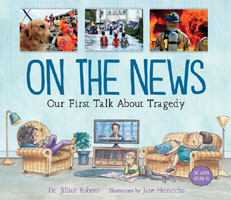| ________________
CM . . .
. Volume XXIV Number 39. . . .June 8, 2018

 |
On the News: Our First Talk About Tragedy. (The World Around Us).
Jillian Roberts. Illustrated by Jane Heinrichs.
Victoria, BC: Orca, Sept., 2018.
32 pp., hc., pdf & epub, $19.95 (hc.).
ISBN 978-1-4598-1784-5 (hc.), ISBN 978-1-4598-1785-2 (pdf), ISBN 978-1-4598-1786-9 (epub).
Subject Headings:
Disasters-Juvenile literature.
Disasters-Psychological aspects-Juvenile literature.
Grades 2-4 / Ages 7-9.
Review by Linda Ludke.
**** /4
Reviewed from Advance Reading Copy.
|
| |
|

excerpt:
I saw on the news today that something bad had happened in the city. Many people were hurt, and some were killed. I felt so sad and scared.
I understand how you feel. I feel the same way when I see or hear things like that on the news. The world can be a complicated and confusing place. It is hard to accept that something very bad things happen in the world around us.
On The News: Our First Talk about Tragedy is the second book in “The World Around Us” series, the first being On Our Street: Our First Talk about Poverty, that introduces children to complex cultural, social and environmental issues. As in the first entry, this nonfiction picture book tackles realities in the world that are hard for everyone, adults and children alike, to comprehend and process. Media, in all of its many sources, is streaming constantly around all of us. The preface acknowledges the tendency to avoid talking about difficult subjects, and it takes the affirmative stand that “It is okay to ask questions when you do not understand why something bad has happened in the world.”
The question and answer format supports the importance of having conversations about natural disasters, terrorism, and other heartbreaking events that happen both locally and globally. Written by Dr. Jillian Roberts, a child psychologist, professor and parent, the content is clearly written, realistic, personal and age appropriate. Tough, existential questions, like “Why do tragedies happen?”, are answered simply and honestly: “No one knows for sure why tragedies occur. Part of understanding tragedies is accepting that most of the time we cannot control them.”
The first half of the book sensitively explores events that are out of our hands, events like fires, floods, earthquakes, and other natural disasters. It is also recognized that people can cause tragedies both by accident and on purpose. The second half addresses how children can react and manage their emotions. With an emphasis on compassion and resilience, Dr. Roberts gives her own ideas on how tragic events may provide an opportunity to show strength and help others. The final answer offers empowering, concrete examples of ways children can help when disasters occur, such as showing respect to first responders and participating in fundraising efforts.
Supporting the text are full-colour, stock photographs from around the world. The non-sensational pictures depict families in refugee camps, workers investigating an oil spill, and firefighters putting out a blaze. The most affecting and effective photo shows three young boys walking arm in arm in arm down a bombed street, heading towards the demolished wreckage of a former building. Jane Heinrichs’ delicate, watercolour illustrations are scattered throughout the book and show a diverse group of children reflecting upon and discussing the images and text.
Sidebars provide brief definitions of terms like “tragedy” and “resilience”; statistics from The World Health Organization; a brief list of natural and technological disasters and terrorist events that have happened in the 20th and 21st centuries; and quotations from Elisabeth Kubler-Ross and Eckhart Tolle. A list of resources is included at the end.
On The News: Our First Talk about Tragedy is an accessible, honest conversation starter that is a must-have purchase for all school and public library collections.
Highly Recommended.
Linda Ludke is a librarian in London, ON.

© CM Association
CC BY-NC-ND
Hosted by:
University of Manitoba
ISSN 1201-9364
|
This Creative Commons license allows you to download the review and share it with others as long as you credit the CM Association. You cannot change the review in any way or use it commercially.
Commercial use is available through a contract with the CM Association. This Creative Commons license allows publishers whose works are being reviewed to download and share said CM reviews provided you credit the CM Association. |
Next Review | Table of Contents for This Issue - June 8, 2018.
CM Home | Back Issues | Search | CM Archive | Profiles Archive
|
